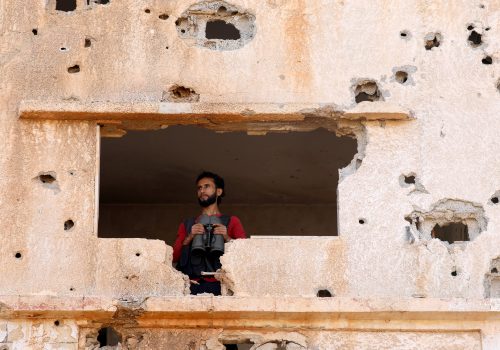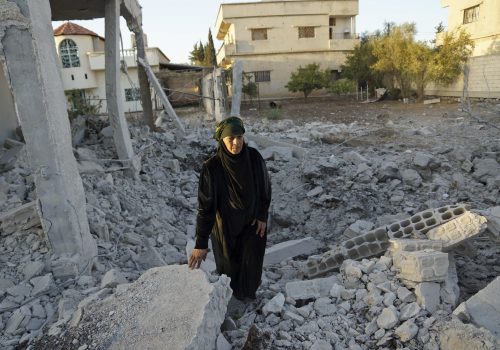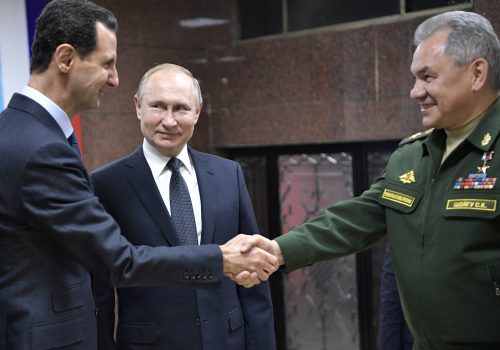The northern countryside of Homs in Syria is facing a similar fate as Daraa
The northern countryside of Homs holds great importance in the context of the Syrian civil war. The people of Homs city, known as the “capital of the Syrian revolution,” are tribally linked to its northern countryside and its strategic location connects the capital Damascus and Aleppo. Its provincial cities and towns have also participated in the demonstrations since the Syrian uprising in 2011.
Residents and defectors from the Syrian army established armed groups to fight against the Bashar al-Assad regime in 2012 and controlled the area until 2018. The northern countryside of Homs witnessed increasing episodes of sectarian violence throughout the conflict. It was subjected to siege and bombing by the Assad regime from 2014 until its recapture and a subsequent reconciliation agreement in May 2018. But, recently, a series of attacks against regime forces and threats by regime commanders are exposing the region to a similar fate as Daraa governorate. In June 2018, locals in Daraa reached a similar reconciliation agreement with the regime, only for the Syrian army to launch a military attack against Daraa al-Balaad to fully capture it and force a new deal that allows the regime to enter all areas.
In April 2018, after the Assad regime recaptured Eastern Ghouta, Syrian army forces headed to the northern countryside of Homs to retake control. Military operations began, accompanied by aerial bombardments that targeted civilians and civilian objects, including hospitals and schools—a common tactic used by the Assad regime against opposition-held areas, which also constitutes a war crime. After less than a month of intermittent fighting and negotiations, the Syrian army and a committee comprised of local figures, opposition commanders, and the Syrian al-Ghad Movement—an opposition political party led by former Syrian Coalition President Ahmad al-Jarba—reached a reconciliation agreement under Russian auspices in May 2018.
The agreement displaced civilians and fighters who refused to stay and sign the reconciliation agreement; offered civilians and defectors six months before being required to join compulsory military service; banned Syrian regime forces entering the region for the first six months since recapture; and transformed the Jaish al-Tawhid faction, an armed opposition group from Talbise town, into a local police force under the command of the Russian military police. However, as with other instances, the Syrian army violated the terms of the agreement and entered the area earlier than agreed.
Regime forces immediately started to arrest civilians following the former’s return to the northern countryside, including civil defense volunteers, defectors, and even members of the local reconciliation committee. After the reconciliation, Russia followed the same tactic in Daraa governorate by using former opposition fighters to its benefit. The Russian military police issued identification cards for the local auxiliary force after the fighters finished the settlement process. The auxiliary force was eventually dissolved and some fighters were either transferred to the Fifth Corps—a Russian-backed division of the Syrian army that consists of reconciled former opposition fighters—or went back to civilian life.
Following the May 2018 reconciliation agreement, Iran-backed forces, such as the Fourth Division, expanded their presence in the northern countryside. The regime’s continued neglect of these areas in terms of services and reconstruction as well as continued human rights violations—such as arbitrary arrests, forced disappearances, and personal grievances cases filed by pro-regime locals, who accused opposition fighters of killing and kidnapping loved ones or destroying their properties—contributed to growing resentment against the Assad regime. Despite this so-called reconciliation agreement, several members of the reconciliation committee fled to Lebanon out of fear of being detained.
The security situation and the emergence of local resistance cells
In June 2019, a year after the Syrian army took control of the northern countryside, a channel on Telegram announced the establishment of a group calling itself “The Resistance Brigades in Homs.” The statement said that the group formed due to Russia’s failure to fulfill its obligations to the region and the regime’s use of conscripted youth in the battles in northwest Syria against opposition forces. The Resistance Brigades claimed nine attacks on regime forces between September 2019 and December 2020, targeting checkpoints and military bases.
In October 2020, another armed group calling itself the “Brigades of 2011” announced that it would start carrying out attacks against the Syrian army, security services, and national defense militias—a local pro-regime militia affiliated with the security apparatus—in the northern countryside due to rights abuses committed by the regime in the region. In mid-November 2020, the armed group announced that they targeted a building belonging to state security in the city of Talbiseh in the northern countryside, a day before a scheduled celebration for the Baath Party. A statement published by the Brigades of 2011 said that the rapid increase in COVID-19 cases was the reason behind the attack. In May, while the country was preparing for the presidential elections, the armed group took credit for attacking an election celebration in the village of Farhaniya. Armed men on a motorcycle shot into the crowd, killing one person. Then, in July, the armed group again took credit for assassinating an army corporal at his home and assassinating another first lieutenant in mid-August.
After these developments and, following the decision of the regime to send military reinforcements to the region, Major General Hossam Loqa, director of the General Intelligence Branch, met with local figures and the reconciliation committee in late August. Loqa threatened to launch a military operation unless the perpetrators involved in the attacks were handed over, in addition to handing over individual weapons and demanding six hundred personnel of Jaysh al-Tawhid for military service. Thus far, there has neither been a military operation nor a new settlement.
Reconciliation agreements fail to bring peace and stability
The northern countryside of Homs is facing a scenario similar to Daraa, as the Assad regime has shown a lack of commitment to the settlement agreements signed by several regions across Syria, and countless human rights violations have continued. However, because the northern countryside of Homs is a tribal society and many army officers are from the area, especially Rastan—the biggest city in the northern countryside—the region may avoid a siege scenario like Daraa and a large-scale military operation if they reach an agreement with the Assad regime. This is partly because of the limited sleeper cell attacks against regime forces compared to those in Daraa governorate.
Still, the Assad regime’s condition of six hundred young men joining conscription will be the biggest obstacle to implementing any agreement. This is yet another example of the so-called reconciliation agreement’s failure to bring stability and peace to Syria, as these agreements are built over destruction and rights abuses rather than any genuine and sustainable reconciliation. It is also another example of failed Russian promises to provide security for Syrians and how Moscow uses temporary reconciliation settlements as a step to execute its longer term, wider agenda in the country.
Suhail al-Ghazi is a Syrian researcher and OSINT expert. He is currently a Syria researcher with ORSAM Center for Middle East Studies and former non-resident fellow at Tahrir Institute for Middle East Policy. Follow him on Twitter: @putintintin1.
Image: Maysaa Mahmoud, five-year-old Syrian displaced child from Homs countryside, poses for a picture in a tent at Atmeh camp, near the Turkish border, Syria June 19, 2020. Picture taken June 19, 2020. REUTERS/Khalil Ashawi


